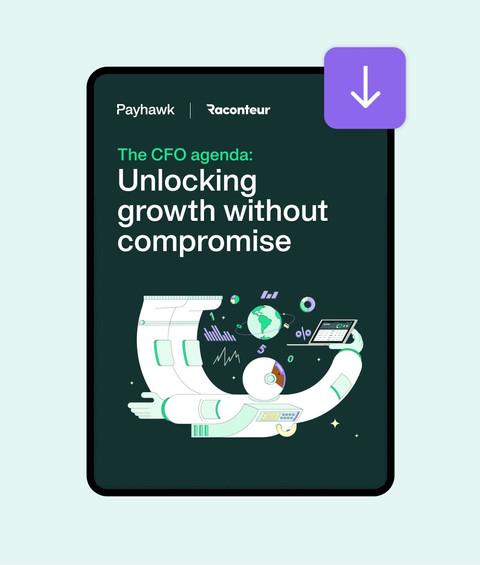
CFOs: Do businesses really need to compromise in the current climate?



Finding efficiencies and exerting better financial control could help businesses avoid service or product sacrifices. Discover how in the article (featuring key stats and insights from top industry professionals).
By submitting this form, you agree to receive emails about our products and services per our Privacy Policy.
Editorial note: This article is a derivative of the Payhawk x Raconteur report, The CFO agenda: Unlocking growth without compromise
With economic strains globally continuing to impact operating conditions, CFOs are under increased pressure to reduce costs and improve efficiency to maintain profitability. For some companies, this has meant accepting trade-offs which potentially compromise the customer experience, either by raising prices or reducing product quality.
Uncover top CFO insights on driving growth without compromise

According to Raconteur and Payhawk’s research, 58% of corporate leaders said they had to make or are considering making compromises to survive in the current economic climate. Larger businesses were also more likely to have made compromises, the data showed.
Konstantin Dzhengozov, co-founder and CFO at Payhawk, says
The main issue companies face is the route to profitability. Interest rates are high and forecast to stay high, at least for the foreseeable future. There is a lot of uncertainty in global markets – are we going to go into recession or is the worst over? So to maintain top-line growth in this environment, companies are often forced to make compromises.
Half of respondents say they are navigating this tougher economic climate by increasing customer costs, while 48% said they have reduced their number of products. However, compromising on quality is off-limits for some companies.

“No matter the challenges, quality to the customer is paramount,” says Vijay Padmanabhan, CFO at digital transformation consultancy UST.
When it comes to price increases, we will have a conversation with the customer about the realities of the market and as much as possible work with them. Sometimes we’ll have to pass the cost on, but other times we might be able to find innovative ways to manage costs.
This latter approach taps into a concept coined by authors Jim Collins and Jerry Porras called ‘the genius of the AND’ – the idea that good leaders are capable of achieving seemingly opposing goals at the same time. Instead of thinking in terms of cutting costs or maintaining the customer experience, CFOs should be committed to cutting costs and maintaining the customer experience.
There are several ways finance leaders can achieve this, for starters by cutting back on unused or overpriced subscriptions.
“We are continually assessing each quarter all the different tools that we’re using before we renew a software subscription,” says Dzhengozov.
We carry out a very deep dive internally and ask, are we using this? Do we need it? Is there an alternative supplier that can provide the same thing at a cheaper cost? So we’re really obsessed with subscription spend because it’s a very big expense for us and for a lot of companies nowadays.
Advances in technology, such as the advent of generative AI, are also helping companies find ways to cut costs without compromising on the customer experience.
Padmanabhan says:
We are investing in GenAI to improve the productivity of our software engineers and we’re also looking at automation to improve efficiency, so it’s about using new tech to reduce costs.

Stricter financial controls over spend can also help CFOs navigate the current economic climate, especially by adjusting spending in ways that are more tailored to customer needs.
Vineta Bajaj, CFO at online grocery delivery business Rohlik Group, says:
If you want to guarantee long-term financial stability without compromising on the customer experience, I suggest implementing rigorous cost control measures by leveraging data analytics for insights into customer preferences. This will enable you to optimise your operational procedures in ways that will benefit your customers.
CFOs should also closely scrutinize existing working practices to see if redesigning workflows could yield potential cost savings.
“Streamlining your operations to eliminate redundancies enables you to cut down on expenses without skimping on the service quality your customers have grown accustomed to,” says Bajaj.
Getting a grip on unnecessary costs will also require CFOs to be able to view corporate spend across the business in real time, helping them more accurately pinpoint wastage and quickly address those expenditures. This can help avoid costs stacking up if such monitoring is only performed periodically.
“Visibility and real-time data is the one thing that is critical – if you don’t have visibility on what’s happening with the business and why you are spending X amount of money on a particular expense in a timely manner, then it’s difficult to manage costs effectively,” says Dzhengozov.

To guarantee long-term financial stability without compromising on CX, [try to implement] rigorous cost control measures by leveraging data analytics for insights into customer preferences
In this climate, therefore, CFOs need to adopt a financial strategy that is laser-focused on using resources more efficiently and eliminating unnecessary expenses wherever possible.
“You have to look at your priorities and where you are investing very carefully,” says Padmanabhan. “You have to focus on growth, without growth companies can’t survive. So you need to identify the key growth areas and cut out areas where you don’t see growth or where the future is not so bright.”
Given the scale of economic uncertainty, a good financial strategy in the current environment also needs to be agile and adaptable so organizations can better react to market shifts.
Dzhengozov says:
You need to plan for at least two or three scenarios and you need to readjust constantly based on current market conditions and every signal that you get from your customers, because you might be way too optimistic or way too pessimistic. The best plan is to execute on your vision, but keep updating it and keep everything very flexible so that you don’t end up with a very unpleasant surprise.
By taking these steps, organisations have a better chance of more effectively managing their costs without compromising on customer experience.
Want to learn more about how CFOs are navigating today's challenges without compromising on growth? Dive into the full report for key insights and strategies from industry leaders.
The Payhawk Editorial Team consists seasoned finance professionals boasting years of experience in spend management, digital transformation, and the finance profession. We're dedicated to delivering insightful content to empower your financial journey.
Related Articles


The true price of bank-issued cards for finance teams
